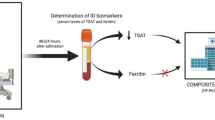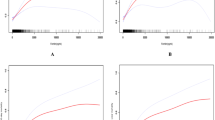Abstract
Background
Ferritin is an iron deposition protein and a commonly ordered clinical test. While high levels may signify iron deposition, the majority are due to metabolic, inflammatory, infectious, and malignant disorders. The association between ferritin elevations < 1000 μg/L and long-term mortality is well demonstrated. The association between extreme ferritin elevations, namely ferritin levels over 10,000 μg/L, and short-term mortality, as well as predictors of mortality, has not been defined.
Methodology
A retrospective chart study was designed in an academic hospital to analyze the clinical, laboratory, and mortality characteristics of patients whose ferritin is over 10,000 μg/L. Patients from 2012 to 2023 in a large academic center’s electronic medical records were analyzed. Demographics, underlying disorders, laboratory values, mortality status, and days to mortality were acquired. Multivariate logistic regression analysis was used to define predictors of mortality. The Kaplan–Meier survival curve was used to analyze survival.
Results
Sixty-seven patients were identified to have ferritin levels over 10,000 μg/L. The most common underlying disorders were infectious diseases and malignancies. Predictors of mortality in the multivariate logistic regression model were also infectious disease (odds ratio (OR) = 5.35), and malignancy (OR = 6.56), as well as age (OR = 1.05). The area under the curve of the model was .86. 1-year mortality was 62%. Of the patients who died, median survival was 5 days; 30- and 90-day mortality were 80% and 92%, respectively.
Discussion
Extreme hyperferritinemia is associated with high short-term mortality. Ferritin can be used as a marker of poor prognosis, particularly among patients with infection and malignancy.


Similar content being viewed by others
Data availability
Data is available upon reasonable request.
References
Cullis JO, Fitzsimons EJ, Griffiths WJ et al (2018) Investigation and management of a raised serum ferritin. Br J Haematol 181(3):331–40
Sandnes M, Ulvik RJ, Vorland M, Reikvam H (2021) Hyperferritinemia—a clinical overview. J Clin Med 10(9):2008
Ganz T (2019) Anemia of Inflammation. N Engl J Med 381(12):1148–1157
Hearnshaw S, Thompson NP, McGill A (2006) The epidemiology of hyperferritinaemia. World J Gastroenterol 12(36):5866–5869
Adams PC, Reboussin DM, Barton JC et al (2005) Hemochromatosis and iron-overload screening in a racially diverse population. N Engl J Med 352(17):1769–1778
Ellervik C, Marott JL, Tybjærg-Hansen A et al (2014) Total and cause-specific mortality by moderately and markedly increased ferritin concentrations: general population study and metaanalysis. Clin Chem 60(11):1419–1428
Koperdanova M, Cullis JO (2015) Interpreting raised serum ferritin levels. BMJ 3(351):h3692
Kernan KF, Carcillo JA (2017) Hyperferritinemia and inflammation. Int Immunol 29(9):401–409
Dongiovanni P, Fracanzani AL, Fargion S, Valenti L (2011) Iron in fatty liver and in the metabolic syndrome: a promising therapeutic target. J Hepatol 55(4):920–932
Moirand R, Lescoat G, Delamaire D et al (1991) Increase in glycosylated and nonglycosylated serum ferritin in chronic alcoholism and their evolution during alcohol withdrawal. Alcohol Clin Exp Res 15(6):963–969
Schram AM, Campigotto F, Mullally A et al (2015) Marked hyperferritinemia does not predict for HLH in the adult population. Blood 125(10):1548–1552
Otrock ZK, Hock KG, Riley SB et al (2017) Elevated serum ferritin is not specific for hemophagocytic lymphohistiocytosis. Ann Hematol 96(10):1667–1672
Sackett K, Cunderlik M, Sahni N et al (2016) Extreme hyperferritinemia. Am J Clin Pathol 145(5):646–650
Senjo H, Higuchi T, Okada S, Takahashi O (2018) Hyperferritinemia: causes and significance in a general hospital. Hematology 23(10):817–822
Crook MA, Walker PLC (2013) Extreme hyperferritinaemia; clinical causes. J Clin Pathol 66(5):438–440
Belfeki N, Strazzulla A, Picque M, Diamantis S (2020) Extreme hyperferritinemia: etiological spectrum and impact on prognosis. Reumatismo 71(4):199–202
Hearnshaw S (2006) The epidemiology of hyperferritinaemia. World J Gastroenterol 12(36):5866
Waalen J, Felitti VJ, Gelbart T, Beutler E (2008) Screening for hemochromatosis by measuring ferritin levels: a more effective approach. Blood 111(7):3373–3376
Lee MH, Means RT (1995) Extremely elevated serum ferritin levels in a university hospital: associated diseases and clinical significance. Am J Med 98(6):566–571
Zhou F, Yu T, Du R et al (2020) Clinical course and risk factors for mortality of adult inpatients with COVID-19 in Wuhan, China: a retrospective cohort study. The Lancet 395(10229):1054–1062
Funding
No funding was recieved for this study.
Author information
Authors and Affiliations
Contributions
ATG, NH, and AEA conceptualized the study. NH, and AEA performed data collection, ATG performed statistical analysis. ATG, NH, and AEA conducted the draft and final manuscript preparation.
Corresponding author
Ethics declarations
Ethical approval
This study was approved by the Başkent University Institutional Review Board (Project number: KA23/456).
Conflıct of ınterest
All authors declare no conflict of interest.
Additional information
Publisher's Note
Springer Nature remains neutral with regard to jurisdictional claims in published maps and institutional affiliations.
Rights and permissions
Springer Nature or its licensor (e.g. a society or other partner) holds exclusive rights to this article under a publishing agreement with the author(s) or other rightsholder(s); author self-archiving of the accepted manuscript version of this article is solely governed by the terms of such publishing agreement and applicable law.
About this article
Cite this article
Güven, A.T., Hocanın, N. & Ambarkütükoğlu, A.E. Predictors of mortality, mortality rates, and clinical characteristics of adult patients with extreme hyperferritinemia. Ir J Med Sci (2024). https://doi.org/10.1007/s11845-024-03698-2
Received:
Accepted:
Published:
DOI: https://doi.org/10.1007/s11845-024-03698-2




